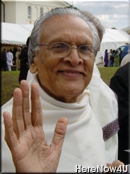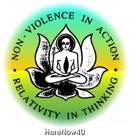

Some say: "All day I sit and pray and nothing happens!" Because action is zero! When action does not synchronize with thought, dichotomy is created.
Wanting to do something and allowing conditions to hold you back makes you withdraw from carrying out a positive thought. Such a withdrawal is a withdrawal from your own commitment to growth as well. If you tell someone that you will help him and then retract your offer the moment he comes to you for aide, you are creating duality in yourself. You are making slices of your whole life. When you know this, you should say to yourself: "I don't want to turn my life into little bits and pieces. Let me live a life where I feel my words, feelings and actions in unison."
It is the nature of the unenlightened mind to take form according to the object before it. If the object tempts the senses, the mind starts desiring it. If it gets what it wants, it becomes temporarily happy. That is called pleasure. If it does not get what it desires, it goes on pining for it. This leads to frustration, which in turn leads to depression. That is called pain. Both pleasure and pain are transitory, the by-products of a mind enslaved to need or greed. Such a mind is nothing but an old dusty attic, filled with the old objects, thoughts, and desires which it has collected, accumulated, and reflected.
As long as the mind is not receiving the light of awareness, it remains in this state of fluctuation, transmitting the vibrations of attraction (raga) or repulsion (dvesha).
At this level, the consciousness of the unaware human being is hardly different from the instinctive consciousness of animals whose desires are merely to eat, sleep, procreate, and collect. When the mind enters a state of depression, it is characterized by a heaviness and immobility comparable to the mineral state.
But we are all on the path of evolution. It is the nature of soul to sprout upward. It is the nature of consciousness to become more and more open. It starts from the mineral state and goes on evolving until at last it reaches the enlightened state of evolution: universal consciousness. Even though the mineral consciousness may not be noticed due to its seeming immobility, it has a slight level of consciousness. We have seen that even the smallest seed has life force, sentient energy. Before it is planted, it is in a state of outer slumber. When it is planted in the ground, its consciousness is evident because of its urge to grow.
The animal consciousness goes through suffering and the natural processes of life: continually coming into contact with different vibrations, continually shedding old forms and putting on new ones. At last it reaches the level of human consciousness or "Who am I" consciousness. No other form of life can ask itself that question.
When a human being undertakes to ask himself that question, he has embarked on a journey to uncover his own reality. He has committed himself to step forward toward evolution. He has begun to enlighten his mind and start using it in the way it was meant to be used - to help sentient energy to become aware of itself.
When sentient energy becomes aware of the Self, it stops permitting the mind to give form to negative elements. When the mind stops creating images of accident, illness and death, these negativities will no longer bombard the mind and negative events will not take place.
When the mind acts as a help rather than a hindrance, it becomes a link between sentient and insentient, between soul and body, between consciousness and expression of consciousness. It will act as a light bulb reflecting the source of the power to which it is connected, conscious enlightening energy. When the mind is functioning as receiver and transmitters of sentient energy, it manifests consciousness through what we call knowledge, recognition, cognition, perception, and memory.
When the mind has become quiet through the use of mantra, and through its enlightened understanding of the philosophy of vibrations and karmas, we can go beyond body, speech, and mind and experience what we are in essence. At the time of a deep meditation, the above-mentioned manifestations of consciousness, knowledge, recognition, and the others, become synonymous, yet inadequate to describe the nonverbal transcendent experience.
As we go beyond body, mind, and language, we slowly start experiencing the nature of atman, which the ancients expressed in this way:
Almanam atmana vetti
Mohatyagad ya atmani
Tad eva tasya charitram
Taj jnanam tacha darshanam

 Clare Rosenfield
Clare Rosenfield